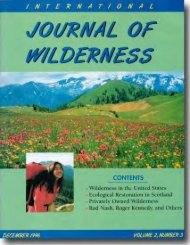Download April 2011 PDF - International Journal of Wilderness
Download April 2011 PDF - International Journal of Wilderness
Download April 2011 PDF - International Journal of Wilderness
Create successful ePaper yourself
Turn your PDF publications into a flip-book with our unique Google optimized e-Paper software.
the increase over time in large downed<br />
woody fuels (fallen snags), increase the<br />
complexity <strong>of</strong> modeling landscape<br />
dynamics. The bark beetle/wildfire<br />
interaction is notable for its ubiquity<br />
across western North America, but<br />
analogous questions obtain in other<br />
fire-insect systems (Jenkins et al.<br />
2008).<br />
If we extend the domain <strong>of</strong> fireecosystem<br />
interactions to other external<br />
and internal drivers, we can then seek<br />
quantitative models that take warming<br />
climate as a primary driver. McKenzie<br />
et al. (2009) built qualitative models <strong>of</strong><br />
the effects <strong>of</strong> warming climate on “stress<br />
complexes,” or cascading interactions<br />
among ecosystem elements that are<br />
intensified by warming temperatures.<br />
Figure 4 shows their model for the<br />
Sierra Nevada mountains in eastern<br />
California, United States. Three external<br />
forcings, all <strong>of</strong> anthropogenic origin<br />
(global warming, fire exclusion, and<br />
ozone pollution), amplify interactions<br />
among fire, insects, and succession to<br />
accelerate forest compositional change<br />
beyond that expected from global<br />
warming by itself. Proportional changes<br />
in the strength <strong>of</strong> each “arrow” in the<br />
complex will propagate through the<br />
system cumulatively, with increasing<br />
uncertainty at each step. This fairly<br />
simple thought experiment is illustrative<br />
<strong>of</strong> the peak in complexity <strong>of</strong><br />
fire-ecosystem interactions at the “landscape”<br />
scale.<br />
Adapting to Changing Fire<br />
Regimes<br />
Given the near certainty that Earth will<br />
continue to warm through the 21st century<br />
regardless <strong>of</strong> global mitigation<br />
policies (Solomon et al. 2009), can protected<br />
areas be managed to adapt<br />
successfully to expected changes in fire<br />
regimes? If so, how will these approaches<br />
differ from adaptation efforts in lands<br />
managed intensively for other resources<br />
(Joyce et al. 2009)? Our work with<br />
public lands managers in the American<br />
West has shown that regardless <strong>of</strong> land<br />
use mandate, adaptation needs to be collaborative,<br />
local, and flexible to<br />
successfully incorporate regionally<br />
unique factors affecting adaptation strat-<br />
Figure 4—Stress complex in forests <strong>of</strong> the Sierra Nevada mountains. Adapted from McKenzie et al.<br />
(2009).<br />
26 <strong>International</strong> <strong>Journal</strong> <strong>of</strong> <strong>Wilderness</strong> APRIL <strong>2011</strong> VOLUME 17, NUMBER 1<br />
egies. At the same time, a broad<br />
conceptual approach to adaptation will<br />
inform the process so that it is proactive<br />
rather than only reactive and so that<br />
common resources and objectives can be<br />
entrained. Millar et al. (2007) provide a<br />
framework for focusing adaptation<br />
efforts that evolves as ecosystem change<br />
accelerates and fewer opportunities<br />
remain for maintaining current conditions.<br />
This framework identifies three<br />
stages: resisting change, promoting resilience<br />
to change, and allowing ecosystems<br />
to respond to change. Table 1 summarizes<br />
local and regional actions associated<br />
with each stage for ecosystems in which<br />
substantial management interventions<br />
are possible. Note that most <strong>of</strong> these<br />
options are unavailable for protected<br />
areas. Clearly, creative solutions are<br />
required to operate within management<br />
constraints (Miller et al. <strong>2011</strong>).<br />
Conclusions<br />
Fire and other disturbances will change<br />
in a warming climate in ways that may<br />
be counterintuitive and relatively<br />
abrupt as the Earth system reacts to the<br />
increased radiative forcing from greenhouse<br />
gas emissions. <strong>Wilderness</strong> and<br />
other protected areas are especially vulnerable<br />
to fire and other disturbances<br />
because they are small, isolated, and<br />
sensitive to environmental effects from<br />
outside their boundaries, valued by<br />
society in their current “equilibrium”<br />
state, and not available for the substantial<br />
manipulations that may help more<br />
managed ecosystems to adapt. Given<br />
that greenhouse warming is unlikely to<br />
abate soon, we can expect significant<br />
changes in protected areas in which fire<br />
is a dominant ecosystem process, in<br />
other words, most <strong>of</strong> them. These<br />
changes are expected to be rapid enough<br />
that attempts to maintain stationary<br />
conditions will likely fail, and adaptation<br />
must be dynamic and anticipate<br />
future landscape composition and










